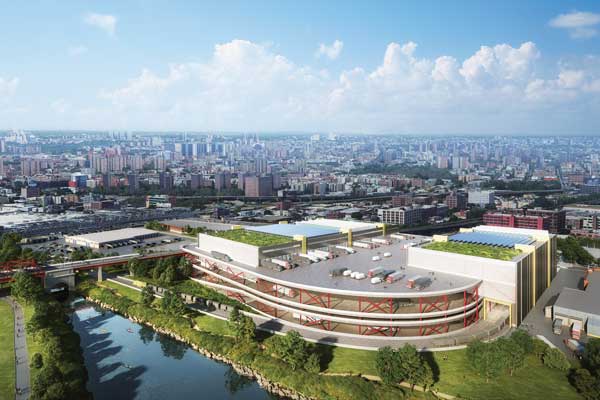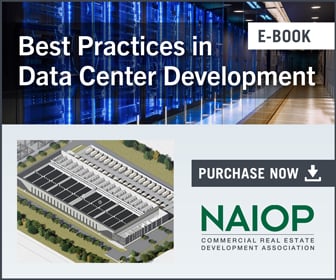Industrial Solutions for E-Commerce Grocery Fulfillment

The pandemic forced the industry to adapt quickly to meet soaring demand.
While grocery e-commerce was growing prior to the pandemic, the sector saw staggering market penetration over the course of 2020 and beyond. Concerned about safely accessing food, consumers across all demographics turned to online grocery shopping as a convenient, safe option.
A survey by LEK indicated that food e-commerce made up 3%-4% of total grocery retail sales before the pandemic and that overall penetration would reach 15%-20% by 2025. But in its February 2021 Online Grocery Report, Business Insider projected online grocery adoption will reach 55% in the U.S. by the end of 2024. Consumers have clearly grown accustomed to the convenience and safety of grocery e-commerce.
While some national grocers filled online orders via strategically placed warehouses close to urban centers, local stores also managed to keep up with same-day delivery demands. This has forced grocers to rethink opportunities to reduce labor costs and the strain on local stores by using gig-economy delivery platforms such as Instacart. Additionally, new models of automation built around goods-to-person systems that support food distribution allow stores to devote more space to stock while effectively transforming them into omnichannel facilities that can manage in-store and e-commerce distribution from the same building.
Couple these changes with increasing consumer demand for local and fresh foods, and the potential to create a truly equitable and sustainable model has never been greater. This transformative model will feature several components — multimodal delivery hubs within an existing network of stores, strategic use of automation through microfulfillment, and expanded vertical farming operations.
Multimodal Network
When early adopters of the food delivery model such as Peapod first started, the mode of delivery was traditional box trucks. The emergence of Amazon’s Sprinter vans for last-mile deliveries has now expanded the speed, reach and nimbleness of delivery across many e-commerce platforms. And, with unemployment reaching 15% at the height of the pandemic, companies such as Amazon and Instacart provided job opportunities to delivery drivers.
A study by visiting MIT Sloan Professor Jordan Nickerson indicates that gig economy platforms, while not perfect, served as a safety net during the pandemic. For example, one data point shows that unemployment claims are nearly 5% lower for people with cars, because it is easier for them to find work as delivery drivers.

The future of e-commerce grocery fulfillment could include multistory, multimodal facilities that will provide a full range of access and supply. KSS Architects
That said, congestion in dense urban areas has increased opportunities for bike delivery models that companies like DHL and Amazon are exploring. Energy-efficient cargo bikes are also emerging as a viable secondary means of delivery. Concerns about the space that urban bike delivery companies take up on sidewalks would further support on-site vehicle storage and loading capability to avoid street congestion.
Multimodal facilities must have space for pick-up and queuing. Therefore, facilities with on-site parking, queuing and loading structures with clear access and ease of movement will thrive. Access to both local streets and multiple highways will further enhance location as cars, vans and bikes meet the growing demand for e-commerce deliveries. The ultimate multimodal solution will provide a full range of access and supply — from an open retail street presence to the utilization of drone delivery as regulations and other hurdles for that transport mode are overcome.
Microfulfillment
Microfulfillment centers (MFCs) provide the opportunity to create socially sustainable supply chains built around customer loyalty and local presence. According to March 2021 research from Bain & Company, stores using staff to fill orders in-store for delivery lose 10%-15% profit per order. But data provided by AutoStore shows that smaller, highly automated warehouses can cut profit losses in half. And an analysis by financial firm Jefferies determined that “microfulfillment could reduce order-related costs by as much as 75%,” thus increasing revenue.
These centers use the same automated storage and retrieval system (ASRS) technology as a full-size distribution center, at a much smaller scale — typically within 3,000-10,000 square feet. When located near consumers, whether attached to the grocer or within the store itself, this streamlined solution shortens the time from online order placement to pick-up or delivery.
As a building typology, MFCs are part of an agile omnichannel system that depends on both humans and robotics, creating a sustainable supply chain and offering increased opportunities for grocers and gig workers. Seamless, frictionless goods delivery systems like those by Autostore by Redline offer increased storage density — sometimes four times as much product than traditional racking — and are flexible and expandable. Crucially for urban sites, MFCs can reduce square footage needed for product to 25% of the floor area needed for traditional systems.
Goods stored in bins within the storage grid are retrieved by robotic picking and dropped off to an order assembler, then go straight to the delivery drivers. “Dark stores” built for fulfillment without direct access by consumers, like those by Whole Foods and others, are also emerging. Factor the spatial premiums on urban sites and the enhanced storage volume per square foot that MFCs offer, and the benefit is further enhanced.
Vertical Farming
COVID-19 has had a significant impact on urban centers that were already suffering from a lack of access to food and jobs. Companies like AeroFarms have been working to address this inequity through vertical farming, providing access to fresh, locally grown produce.
Vertical farms, such as AeroFarms’ in Newark, New Jersey, can harvest up to two million pounds of fresh greens per year in just 70,000 square feet of space. These systems use less water, less energy and require less skilled labor to produce a reliable yield of consistent quality. Vertical farming is a global industry, estimated at $2.23 billion in 2018. It’s poised to grow to $12.77 billion by 2026. Urban areas with tight footprints and limited sunlight can benefit from these farms, which offer fresh, local, sustainable food to communities year-round. In conjunction with multimodal MFCs, this concept could produce an urban model of supply that brings food to the literal door of a large customer base. (Development profiled a vertical farm in the Chicago area in the Winter 2020-2021 issue.)
Integrated Solutions
COVID-19 accelerated the growth of grocery e-commerce, prompting developers to respond with more efficient, cost-effective ways to meet demand. The solution is facilities that are integrated, multi-dimensional and sustainable. Ideally, these buildings merge strategically located, multimodal delivery food hubs with the pre-existing network of stores, utilize gig-economy delivery platforms, employ the strategic use of automation via microfulfillment, and expand vertical farming operations. These facilities will enable grocers to increase their supply chain connectivity and distribution networks.
Furthermore, development that weaves together multiple uses will maximize the value of urban sites, create synergies for end users and local communities, and ultimately, be viable into the future.
Scot Murdoch, AIA, is a partner with KSS Architects.




